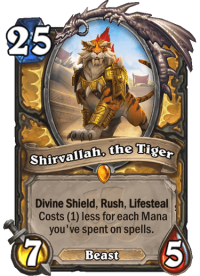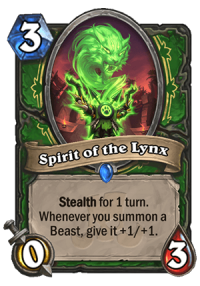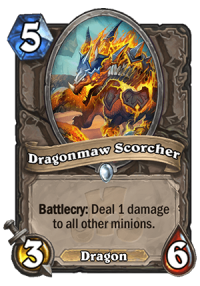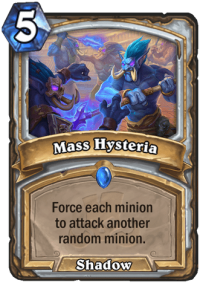Boy oh boy. The Rumble isn’t exactly considered a popular set by the community, the posterboy of the comparatively lower power levels on display in the Year of the Raven. With most of the year colored by the Even/Odd archetypes, many of The Boomsday Project’s cards found a new lease of life once Genn and Baku were rotated prematurely. Was this the case with Rastakhan’s Rumble as well or did it fall short in the first knockout round? Let’s take a look…
End-Of-Year Sets: A Unique Conundrum

It’s not at all straightforward to gauge the power level of the final set of a Hearthstone year during development. Since they are available in Standard for the shortest possible time, they are understandably expected to have a higher Constructed viability than the previous ones – both from a simple bang-for-your-buck perspective and because they arrive when the card pool is at its largest, meaning the competition for a slot in your 30-card deck is as high as it gets. That isn’t to say you can’t overshoot: Kobolds and Catacombs and arguably Descent of Dragons have both gone somewhat overboard, dominating the metagame throughout their life cycle in Standard.
It’s safe to say Rastakhan’s Rumble won’t be remembered as such. In fact, if you look through the different offerings of the set, it’s surprisingly lackluster compared to the previous ones, with fewer unique keywords and a solo content which was mostly a rehash of its Witchwood predecessor. In fact, this lends further credence to the theory that this was supposed to be the expansion where the scrapped tournament mode was supposed to arrive, originally a part of the 2018 roadmap and a good thematic fit for the troll competition theme of the set.
So what was left to work with? Not much, as it turns out. The last set which was put into production during Ben Brode’s time (remember that Team 5 basically works a year advance on new content) went out with a whimper, not a bang.
Shrines and Overkill

Though the Loas and the Troll champions served as theming tools for the class legendaries, these characterizations had no gameplay impact. All in all, only two keywords were introduced in Rastakhan’s Rumble, neither seen at all since the set’s release and with very limited Constructed impact as a whole.
Shrines are essentially a zero-for-one tool with a one-turn grace period thanks to their one-turn Stealth effect, which means you’re already starting from behind when trying to generate tempo or value off of them. No wonder most of them ended up useless: not only is this a huge mountain to climb, but most of them had way too specific effects, and with no corresponding archetype taking off, they had no chance to thrive. Spirit of the Bat was too slow even for Zoo, much like how Hunter couldn’t make use of Spirit of the Lynx and Paladins never touched Spirit of the Tiger. Spirit of the Dragonhawk made no sense outside of Odd Mage (which only had a few months left to live at this point), Spirit of the Raptor relied on a Hero Power-based Druid which never came to be, Spirit of the Rhino only saw fringe play due to the same reasons, though it made the occasional appearance in high-Legend decks. On the other side of the spectrum, Spirit of the Frog allowed enough redraws to warrant play in spell-heavy Shaman decks and Spirit of the Dead was a fringe inclusion in hyper-Control Priest builds for fatigue considerations, but that was about it. Famously, Spirit of the Shark pretty much turned out to be a deckbuilding trap card.
Overkill faced a similar hurdle, having to reward a waste of resources by providing… additional resources. Since it focuses on minion killing, it also has little to no application in aggressive archetypes either. Not only that, but the Overkill cards without a lack of initiative were often just killed for free due to the stats they sacrificed for the keyword. The math rarely worked out in the end, even if their value generation possibilities made many of them fairly strong in the Arena. Ultimately, it’s just not an interesting keyword and it makes sense that it wasn’t seen since in the game. Hunter decks found a home for Baited Arrow, at least as long as Zul'jin was around (though it was functionally a 5 mana 5/5 which dealt 3 damage), just in spell form and Oondasta in certain Recruit builds, while Blast Wave was seen in Odd Mage builds for a short period of time and Half-Time Scavenger was an acceptable anti-aggro tech option.
Notable Cards (Or Lack Thereof)

The rest of the cards of Rastakhan’s Rumble also didn’t exactly set the world alight, with only a small portion finding Constructed relevance during their time in Standard. A Dragon shell in the neutrals (Dragonmaw Scorcher, Firetree Witchdoctor and Crowd Roaster) played a part in slower Dragon synergy decks, while the rest were basically archetypal one-offs: Scarab Egg found a home in token-y builds, Banana Buffoon was basically a Mage card in all but name, much like how Mosh'ogg Enforcer belonged to Anduin, Masked Contender was a Hunter thing all along and Soup Vendor was occasionally used in Holy Wrath Paladin. Da Undatakah was a part of many oddball finishers and desperate anti-Warrior builds, similarly to Hakkar, the Soulflayer.
Moving on to the class cards department, Rastakhan’s Rumble looks as barren as a Walmart toilet paper section in the middle of a pandemic. Practically none of the Druid cards saw play apart from Wardruid Loti, and even that was only seen due to a mechanic which didn’t exist at the time it was printed in Standard. Warrior suffered a similar fate (with perhaps the exception of Devastate), not that it needed a lot of help off the back of Dr. Boom’s mad genius. Warlock had Grim Rally, and that was about it. Though Mage’s Elemental Evocation became a star (especially in light of Mountain Giant’s newfound tribal tag), the rest was also pretty much a dud. As long as Odd Mage was a thing, Daring Fire-Eater, Pyromaniac, and Jan'alai, the Dragonhawk had some niche applications but they went out of the metagame with Baku the Mooneater for good.

That’s not to say everyone got the short end of the stick. Paladin’s got basically its only viable archetype for a two-year period with Shirvallah, the Tiger, Flash of Light and Time Out! (alongside High Priest Thekal for the mirror) – unfortunately, Immortal Prelate turned out to be way too slow to enable long forgotten Control Paladin builds. Priest could play around with Seance and Grave Horror, but Mass Hysteria (you know, their annual AoE card to shore up their evergreen weaknesses) was the star of the show, with Bwonsamdi, the Dead also playing a critical role in Combo Priest builds. Rogue’s Raiding Party turned out to be a nerf candidate during Rise of Shadows and Walk the Plank was a viable tech choice in Mountain Giant-infested metagames, but that (and the shrine) was about as good as it got for Valeera.
The real winner here was Hunter, with a complement of cards which kept the class afloat for a year. Starting with Zul'jin – the real enabler of spell-based builds due to its incredible reload – and the aforementioned Baited Arrow, Springpaw was an ultra-flexible and high-impact one-mana card, Headhunter's Hatchet was a nice tool for midrange-y Beast decks alongside the occasional Revenge of the Wild tech, while Halazzi, the Lynx finally got some time in the spotlight in Quest Hunter just as it was about to rotate out of Standard. Of course, the real deal was Master's Call, a mega-resource generating tool, but one which, in retrospect, was perhaps the target of unwarranted ire by the community. Though that specific Standard card pool made it an incredible card, it’s not been a recurring problem card throughout the Year of the Dragon, and with the rest of the set’s offerings in mind, perhaps that sort of power spike is something we’ll ever remember fondly. Lord knows there isn’t much else to celebrate about Rastakhan’s Rumble – compared to every other end-of-year Standard set (Mean Streets of Gadgetzan, Kobolds and Catacombs and Descent of Dragons), it falls woefully short.

> Spirit of the Dragonhawk made no sense outside of Odd Mage
Well… it’s also a 2 mana card. It wouldn’t have made sense inside of Odd Mage, either.
But that’s exactly the point. The card was designed for hero power mage but they made it two mana which just didn’t make any sense. Thus the card was dead even before its arrival.
Sad and true!!
Nice walk trought horrible cards. xD Spring Paw don’t go to the light!